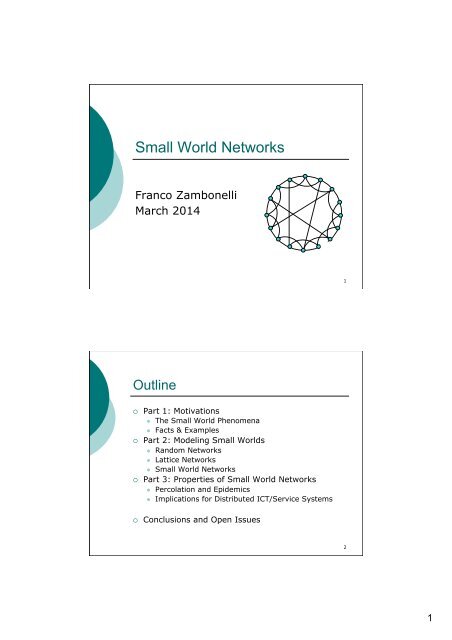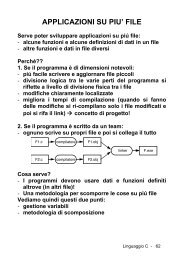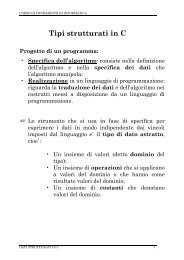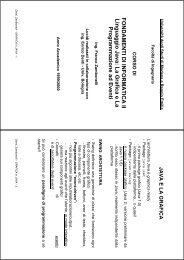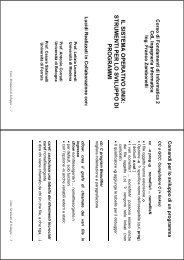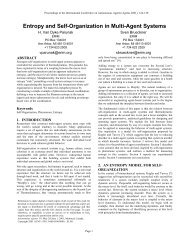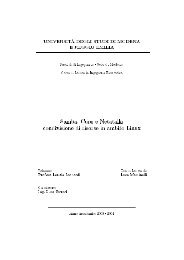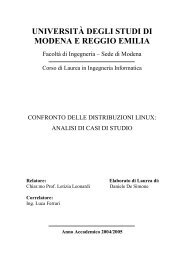Small World Networks
Small World Networks
Small World Networks
Create successful ePaper yourself
Turn your PDF publications into a flip-book with our unique Google optimized e-Paper software.
<strong>Small</strong> <strong>World</strong> <strong>Networks</strong><br />
Franco Zambonelli<br />
March 2014<br />
1<br />
Outline<br />
¡<br />
¡<br />
¡<br />
Part 1: Motivations<br />
l The <strong>Small</strong> <strong>World</strong> Phenomena<br />
l Facts & Examples<br />
Part 2: Modeling <strong>Small</strong> <strong>World</strong>s<br />
l Random <strong>Networks</strong><br />
l Lattice <strong>Networks</strong><br />
l <strong>Small</strong> <strong>World</strong> <strong>Networks</strong><br />
Part 3: Properties of <strong>Small</strong> <strong>World</strong> <strong>Networks</strong><br />
l Percolation and Epidemics<br />
l Implications for Distributed ICT/Service Systems<br />
¡<br />
Conclusions and Open Issues<br />
2<br />
1
Part 1<br />
¡ Motivations<br />
3<br />
Let’s Start with Social <strong>Networks</strong><br />
¡ We live in a connected social world<br />
l We have friends and acquaintances<br />
l We continuously meet new people<br />
l But how are we connected to the rest of the<br />
world<br />
¡ We have some relationships with other<br />
persons – thus we are the nodes of a<br />
“social network”<br />
l Which structure such “social network” has<br />
l And what properties does it have<br />
4<br />
2
“Hey, it’s a <strong>Small</strong> <strong>World</strong>!”<br />
¡ How often has is happened to meet a new<br />
friend<br />
l Coming form a different neighborhood<br />
l Coming from a different town<br />
¡ And after some talking discovering with<br />
surprise you have a common<br />
acquaintance<br />
l “Ah! You know Peter too!”<br />
l “It’s a small world after all!”<br />
¡ Is this just a chance of there is something<br />
more scientific behind that<br />
5<br />
The Milgram Experiment (1967)<br />
¡ From Harvard University, he sent out to randomly<br />
chosen person in the US a letter<br />
¡ Each letter had the goal of eventually reaching a<br />
target person (typically a Milgram’s friend), and it<br />
prescribe the receiver to:<br />
l If you know the target on a personal basis, send the<br />
letter directly to him/her<br />
l If you do not know the target on a personal basis,<br />
re-mail the letter to a personal acquaintance who is<br />
more likely than you to know the target person<br />
l Sign your name on the letter, so that I (Milgram) can<br />
keep track of the progresses to destination<br />
¡ Has any of the letters eventually reached the<br />
target How long could that have taken<br />
¡ Would you like to try it by yourself<br />
l http://smallworld.columbia.edu/<br />
6<br />
3
Results of Milgram’s Experiment<br />
¡ Surprisingly<br />
l 42 out 160 letter made it<br />
l With an average of intermediate persons having received the<br />
letter of 5!<br />
¡ So, USA social network is indeed a “small world”!<br />
l Six degrees of separation on the average between any two<br />
persons in the USA (more recent studies say 5)<br />
l E.g., I know who knows the Rhode Island governor who very<br />
likely knows Condoleeza Rice, who knows president Bush<br />
l Since very likely anyone in the world knows at least one USA<br />
person, the worldwide degree of separation is 6<br />
¡ John Guare: “Six Degree of Separation”, 1991<br />
l “Six degrees of separation. Between us and everybody else in<br />
this planet. The president of the United States. A gondolier in<br />
Venice…It’s not just the big names. It’s anyone. A native in<br />
the rain forest. A Tierra del Fuegan., An Eskimo. I am bound to<br />
everyone in this planet by a trail of six people. It’s a profound<br />
thought. How every person is a new door, opening up into<br />
other worlds”<br />
l 1993 movie with Will Smith<br />
7<br />
Kevin Bacon<br />
Apollo 13<br />
¡<br />
¡<br />
¡<br />
A great actor whose talent is being only recently<br />
recognized<br />
l But he’s on the screen since a long time…<br />
l From “Footloose” to “The Woodsman”<br />
Also known for being the personification of the “small<br />
world” phenomena in the actors’ network<br />
The “Oracle of Bacon”<br />
l http://www.cs.virginia.edu/oracle/<br />
8<br />
4
The “Bacon Distance”<br />
¡<br />
¡<br />
Think of an actor X<br />
l If this actor has made a movie with Kevin Bacon, then its<br />
Bacon Distance is 1<br />
l If this actor has made a movie with actor Y, which has in<br />
turn made a movie with Kevin Bacon, then its Bacon<br />
Distance is 2<br />
l Etc. etc.<br />
Examples:<br />
l Marcello Mastroianni: Bacon Distance 2<br />
¡ Marcello Mastroianni was in Poppies Are Also Flowers (1966)<br />
with Eli Wallach<br />
Eli Wallach was in Mystic River (2003) with Kevin Bacon<br />
l Brad Pitt: Bacon Distance 1<br />
¡ Brad Pitt was in Sleepers (1996) with Kevin Bacon<br />
l Elvis Presley: Bacon Distance 2<br />
¡ Elvis Presley was in Live a Little, Love a Little (1968) with<br />
John (I) Wheeler<br />
John (I) Wheeler was in Apollo 13 (1995) with Kevin Bacon<br />
9<br />
The Hollywood <strong>Small</strong> <strong>World</strong><br />
¡<br />
¡<br />
Have a general look at<br />
Kevin Bacon<br />
numbers…<br />
l Global number of<br />
actors reachable<br />
within at specific<br />
Bacon Distances<br />
l Over a database of<br />
half a million actors<br />
of all ages and<br />
nations…<br />
It’s a small world!!!<br />
l Average degree of<br />
separation around 3<br />
Bacon Number # of People<br />
0 1<br />
1 1802<br />
2 148661<br />
3 421696<br />
4 102759<br />
5 7777<br />
6 940<br />
7 95<br />
8 13<br />
10<br />
5
The Web <strong>Small</strong> <strong>World</strong><br />
¡ Hey, weren’t we talking about “social”<br />
network<br />
l And the Web indeed is<br />
¡ Link are added to pages based on “social”<br />
relationships between pages holders!<br />
¡ The structure of Web links reflects indeed a<br />
social structure<br />
¡ <strong>Small</strong> <strong>World</strong> phenomena in the Web:<br />
l The average “Web distance” (number of clicks<br />
to reach any page from anywhere) is less than<br />
19<br />
l Over a number of more than a billion<br />
(1.000.000.000) documents!!!<br />
¡ Similar considerations for the Facebook<br />
friends networks and for Web services<br />
11<br />
Other Examples of <strong>Small</strong> <strong>World</strong>s<br />
¡ The Internet Topology (routers)<br />
l Average degree of separation 5<br />
l For systems of 200.000 nodes<br />
¡ The network of airlines<br />
l Average degree of separation between any two<br />
airports in the works around 3.5<br />
¡ And more…<br />
l The network of industrial collaborations<br />
l The network of scientific collaborations<br />
l Etc.<br />
¡ How can this phenomena emerge<br />
12<br />
6
Part 2<br />
¡ Modeling <strong>Small</strong> <strong>World</strong> <strong>Networks</strong><br />
13<br />
How Can We Model Social <strong>Networks</strong><br />
¡ It gets complicated…<br />
¡ Relations are “fuzzy”<br />
l How can you really say you know a person<br />
¡ Relations are “asymmetric”<br />
l I may know you, you may not remember me<br />
¡ Relations are not “metric”<br />
l They do not obey the basic trangulation rule<br />
d(X,Z)
Modeling Social <strong>Networks</strong> as Graphs<br />
¡<br />
¡<br />
¡<br />
¡<br />
¡<br />
Assume the components/nodes of the social network are vertices<br />
of a graph<br />
l Simple geometrical “points”<br />
Assume that any acquaintance relation between two vertices is<br />
simply an undirected unweighted edge between the vertices<br />
l Symmetric relations<br />
l A single edge between two vertices<br />
l No fuzziness, a relation either exists or does not exist<br />
Transitivity of relations<br />
l So, distance rules are respected<br />
The graph must be necessarily “sparse”<br />
l Much less edges than possible…<br />
l We do not know “everybody”, but only a small fraction of the world..<br />
As you will see, we will able in any case to understand a lot about<br />
social network…<br />
l From now on, I will use both “graph” and “networks” as synonyms<br />
15<br />
Basic of Graph Modeling (1)<br />
¡<br />
¡<br />
¡<br />
Graph G as<br />
l A vertex set V(G)<br />
l The nodes of the network<br />
l An edge list E(G)<br />
l The relations between vertices<br />
Vertices v and w are said<br />
“connected” if<br />
l there is an edge in the edge list<br />
joining v and w<br />
For now we always assume<br />
that a graph is fully connected<br />
l There are not isolated nodes or<br />
clusters<br />
l Any vertex can be reached by<br />
any other vertex<br />
Edge<br />
Vertex<br />
16<br />
8
Basic of Graph Modeling (2)<br />
¡<br />
¡<br />
¡<br />
The order n of a graph is the<br />
number of its vertices/nodes<br />
The size M of a size is the<br />
number of edges<br />
l Sorry I always get confused<br />
and call “size” the order<br />
l M=n(n-1)/2 for a fully<br />
connected graph<br />
l M
Neighborhood<br />
¡<br />
¡<br />
¡<br />
¡<br />
The neighborhood Г(v) of a vertex v<br />
l Is the subgraph S consisting of all the vertices adjacent to<br />
v, v excluded<br />
l Let us indicate a |Г(v)| the number of vertices of Г(v)<br />
The neighborhood Г(S) of a subgraph S<br />
Is the subgraph that consists of all the vertices<br />
adjacent to any of the vertices of S, S excluded<br />
l S=Г(v), Г(S)= Г(Г(v))= Г 2 (v)<br />
l Г i (v) is the ith neighborhood of v<br />
Distribution sequence Λ<br />
l Λi(v)=∑0ài|Г(v)|<br />
l This counts all the nodes that can be reached from v at a<br />
specific distance<br />
l In a small world, the distribution sequence grows very<br />
fast<br />
19<br />
Clustering (1)<br />
¡ The clustering γv of a<br />
vertex v<br />
l Measures to extent<br />
to which the vertices<br />
adjacent to j are also<br />
adjacent to each<br />
other<br />
l i.e., measure the<br />
amount of edges in<br />
Г(v)<br />
NOT CLUSTERED<br />
v<br />
Г(v)<br />
CLUSTERED<br />
v<br />
Г(v)<br />
20<br />
10
Clustering<br />
¡<br />
¡<br />
¡<br />
The clustering of a vertex v γv (or simply Cv) is<br />
calculated as<br />
l Cv=γv =|E(Г(v))| / (kv 2)<br />
l<br />
That is: the number of edges in the neighborhood of<br />
v divided by the number of possible edges that one<br />
can draw in that neghborhood<br />
The clustering of a graph γ (or simply C) is<br />
calculated as the average of γv for all v<br />
Most real world social networks, are typically<br />
highly clustered<br />
l E.g., I know my best friends and my best friends<br />
know each other<br />
21<br />
Classes of <strong>Networks</strong><br />
¡ Let’s start analyzing different classes of<br />
networks<br />
l And see how and to what extent they exhibit<br />
“small world” characteristics<br />
l And to what extent they are of use in modeling<br />
social and technological networks<br />
¡ Let’s start with two classes at the<br />
opposite extremes<br />
l Lattice networks (as in cellular automata)<br />
l Random networks<br />
22<br />
11
d-Lattice <strong>Networks</strong><br />
¡ d-Lattice networks are regular d-<br />
dimensional k-regular grids of vertices<br />
l 1-d, k=2 it’s a ring<br />
l 2-d, k=4, it’s a mesh<br />
n=36, d=2, k=4<br />
n=16, d=1, k=2<br />
23<br />
Other Examples of d-Lattices<br />
n=36, d=2, k=8<br />
n=16, d=1, k=4<br />
24<br />
12
Properties of d-Lattices<br />
¡ For d=1<br />
l L ∝ n à L=(n(n+k-2)) / (2k(n-1))<br />
l |Г i (v)|=k for any v<br />
l γ = (3k-6)/(4k-4) e.g., = 0,5 for k=4<br />
¡ For d=2<br />
l L ∝ √n<br />
l |Г i (v)|=k<br />
l γ = (4k-16)/(16k-16) e.g. = 0 for k=4<br />
25<br />
Some Actual Data<br />
¡ d=1, n=1000, k=4<br />
l L =125<br />
l γ = 0,5 for k=4<br />
l Good clustering, but not a<br />
small world!!!<br />
¡ d=2, n=10000, k=4<br />
l L = 50<br />
l γ = 0<br />
l Not a small world and not<br />
clustered<br />
¡ Lattice networks are not<br />
small world!!!<br />
l Not realistic representations<br />
of modern networks<br />
26<br />
13
¡<br />
¡<br />
¡<br />
Random <strong>Networks</strong><br />
Very simple to build<br />
l Given a set n of vertices<br />
l draw M edges each of which<br />
connect two randomly<br />
chosen vertices<br />
For a k-regular random<br />
networks<br />
l For each i of the n vertices<br />
l Draw k edges connecting i<br />
with k other randomly<br />
chosen vertices<br />
l Avoiding duplicate edges<br />
and “self” edges<br />
Note that the concept of<br />
dimension lose meaning<br />
n=16, k=3<br />
27<br />
Properties of Random <strong>Networks</strong><br />
¡ For large n<br />
l Each node has k neighbors<br />
l Each connecting it to other k neighbors, for a<br />
total of k 2 nodes<br />
l And so on…<br />
l In general Λi(v)=∑i=0,n|Г(v)|≈k i for any v<br />
¡ Please note that for large n, the probability of<br />
cycles reducing the above estimate is very small<br />
for small i, while such cycles are intrinsic in<br />
lattices<br />
¡ In other words, the neighbours of a node v<br />
typically have other neighbours which, in turns,<br />
are unlikely to be neighbors with each other, in<br />
fact<br />
¡ The clustering factor is low and is about<br />
l γ = k/n<br />
28<br />
14
Length of Random <strong>Networks</strong><br />
¡<br />
¡<br />
¡<br />
¡<br />
Given a random network of order n<br />
l Since Λi(v)=∑i=0,n|Г(v)|≈k i<br />
l There must exists a number L such that n≈k L<br />
l That is, a number L such that, from any v, and<br />
going at distance L, I can reach all the nodes of the<br />
network<br />
Then, such L will approximate the average lenght<br />
of the network<br />
l n≈k L à L = log(n)/log(k)<br />
The “degree of separation” in a random network<br />
grown only logaritmically!!!<br />
Random networks are indeed “small world!!”<br />
29<br />
Some Actual Data<br />
¡ The Hollywood network<br />
l n=500000; k=60 (The Hollywood<br />
network)<br />
l L=log(500000)/log(60)=3,2<br />
l Matches actual data!<br />
¡ The Web network<br />
l n=200000000; k=8<br />
l L=11<br />
¡ Even shorter than in actual data!<br />
30<br />
15
¡<br />
¡<br />
¡<br />
However…<br />
Are random networks a realistic model<br />
l Random networks are not clustered at all!<br />
l This is why they achieve very small degrees of<br />
separations!<br />
We know well social networks are strongly clustered<br />
l We know our friends and our friends know each other<br />
l Web pages of correlated information strongly link to<br />
each others in clustered data<br />
l The network of actors is strongly clustered<br />
¡ E.g., dramatic actors meet often in movies, while they<br />
seldom meet comedians…<br />
l The network of Web services<br />
¡ As well as the network of objects in object-oriented<br />
software systems<br />
We can see this from real data, comparing a random<br />
network model with the real statistical data….<br />
l Making it clear that social networks are different… 31<br />
Random <strong>Networks</strong> vs. Real <strong>Networks</strong> (1)<br />
R. Albert, A. Barabási, Reviews<br />
<strong>Small</strong> world! of Modern Physics 74, 47 (2002).<br />
32<br />
16
Random <strong>Networks</strong> vs. Real <strong>Networks</strong> (2)<br />
Clustered! <br />
R. Albert, A. Barabási, Reviews<br />
of Modern Physics 74, 47 (2002).<br />
33<br />
Towards Realistic <strong>Small</strong> <strong>World</strong> Models<br />
¡<br />
¡<br />
¡<br />
The key consideration<br />
l Real social network are somewhere in between the<br />
“order” of lattices and the “chaos” of random<br />
network, In fact<br />
We know well a limited number of persons that<br />
also know each other<br />
¡ Defining connected clusters, as in d-lattices with<br />
reasonably high k<br />
¡ And thus with reasonably high clustering factors<br />
At the same time, we also know some people here<br />
and there, far from our usual group of friends<br />
l Thus we have some way of escaping far from our<br />
usual group of friends<br />
l Via acquaintance that are like random edges in the<br />
network..<br />
34<br />
17
<strong>Networks</strong> at the Edges of Chaos<br />
¡ The key idea (Watts and Strogatz, 1999)<br />
¡ Social networks must thus be<br />
l Regular enough to promote clustering<br />
l Chaotic enough to promote small degrees of<br />
separation<br />
Real Social<br />
<strong>Networks</strong><br />
Full regularity<br />
Between order and chaos<br />
Full randomness<br />
35<br />
The Watts-Strogatz Model<br />
¡ Let’s start with a regular lattice<br />
l And start re-wiring one of the edges at random<br />
l Continue re-wiring edges one by one<br />
l By continuing this process, the regular lattice<br />
gets progressively transformed into a random<br />
network<br />
Re-wiring<br />
36<br />
18
Let’s Re-wire!<br />
Re-wiring<br />
Re-wiring<br />
Re-wiring<br />
37<br />
So What<br />
¡<br />
¡<br />
¡<br />
¡<br />
Re-wired network are between order and chaos<br />
For limited re-wiring, they preserve a reasonable<br />
regularity<br />
l And thus a reasonable clustering<br />
Still, the exhibit “short-cuts”, i.e., edges that<br />
connect parts of the network that would have<br />
been far away from each other<br />
l This provides for shortening the length of the<br />
network<br />
But how much re-wiring is necessary<br />
38<br />
19
Experimental Results (1)<br />
¡<br />
¡<br />
¡<br />
¡<br />
¡<br />
Doing exact calculation is impossible<br />
But experiments shows that:<br />
l A very very limited amount of re-wiring is enough to<br />
dramatically shorten the length of the network<br />
l To make is as short as a random network<br />
At the same time<br />
l The clustering of the network start decreasing later,<br />
for a higher degree of re-wiring<br />
l Thus<br />
There exists a moderate regime of re-wiring<br />
“between order and chaos” for which the network<br />
l Exhibit “small world behavior”<br />
l Is still clustered!<br />
The same as real-world social networks does!<br />
39<br />
Experimental Results (2)<br />
¡<br />
Here’s how performance graphics could look like…<br />
l The length diminishes immediately<br />
l The clustering a bit later…<br />
Real networks are here!<br />
Regular lattice<br />
Random network<br />
40<br />
20
Experimental Results (3)<br />
¡<br />
Here’s the original graphics of Duncan and<br />
Watts, published on “Nature” (length L and<br />
clustering C normalized)<br />
41<br />
Getting Back to Real <strong>Networks</strong> (1)<br />
<strong>Small</strong> world! <br />
R. Albert, A. Barabási, Reviews<br />
of Modern Physics 74, 47 (2002).<br />
As Random <strong>Networks</strong>! <br />
42<br />
21
Getting Back to Real <strong>Networks</strong><br />
Clustered! <br />
Unlike Random <strong>Networks</strong> <br />
R. Albert, A. Barabási, Reviews<br />
of Modern Physics 74, 47 (2002).<br />
43<br />
Summarizing<br />
¡<br />
¡<br />
¡<br />
May real-world networks exhibit the “small world”<br />
phenomena<br />
l Social networks<br />
l Technological networks<br />
l Biological networks<br />
This emerges because these networks have<br />
l Clustering and “Short-Cuts”<br />
l Getting the best from both regular and random<br />
networks!<br />
l “At the Edges of Chaos”<br />
And this may have dramatic impact on the<br />
dynamics of the processes that take place on such<br />
networks!<br />
l As we analyze later on…<br />
44<br />
22
Part 3<br />
¡ Properties and Dynamics of <strong>Small</strong><br />
<strong>World</strong> <strong>Networks</strong><br />
45<br />
¡<br />
¡<br />
The Spread of Infectious Diseases<br />
Let us assume that a single individual, in a social<br />
network, is initially infected<br />
And that it has a probability 0≤p≤1 to infect its<br />
neighbors (due to the presence of non-susceptible<br />
individuals that do not contract and do not further<br />
re-propagate the infection)<br />
l For p=0, the infection do not spread<br />
l For p=1, the infection spread across the whole network,<br />
if the network is fully connected, in the fastest way<br />
l What happens when 0
Percolation<br />
¡ Percolation: the process by which something (a<br />
fluid, a particle, a disease) diffuse across a medium<br />
(a fluid, a labyrinth, a network)<br />
¡ Percolation threshold: the critical value of a<br />
parameter over which the diffusion process can<br />
complete<br />
l i.e., can diffuse over the (nerarly) whole network<br />
l It is a sort of state transition<br />
¡ In the case of epidemics on social networks<br />
l The percolation threshold is the value pc of p at<br />
which the epidemy diffuse over all the network (“gian<br />
epidemy”)<br />
47<br />
Examples of Percolation on a Ring<br />
p=(n-1)/n<br />
FULL INFECTION!<br />
Infected<br />
Not<br />
susceptible<br />
p=(n-3)/n<br />
LIMITED INFECTION!<br />
PERCOLATION THRESHOLD pc=(n-2)/n<br />
48<br />
24
Non Linearity of Percolation<br />
¡ In general, given a network, percolation<br />
exhibit a “state transition”<br />
l Suddenly, over the threshold, the epidemy<br />
becomes “giant”<br />
100%<br />
Percentage<br />
of infected<br />
individuals<br />
0%<br />
0<br />
pc<br />
1<br />
p<br />
49<br />
Percolation in <strong>Small</strong> <strong>World</strong> <strong>Networks</strong> (1)<br />
¡<br />
¡<br />
¡<br />
In random networks<br />
l The percolation threshold is rather low<br />
In strongly clustered networks<br />
l The percolation threshold is high<br />
In small world networks<br />
l The percolation thresholds approaches that of random<br />
networks, even in the presence of very limited re-wiring<br />
100%<br />
Random networks<br />
Regular networks<br />
Percentage<br />
of infected<br />
individuals<br />
0%<br />
0<br />
1<br />
p<br />
50<br />
25
Percolation in <strong>Small</strong> <strong>World</strong> <strong>Networks</strong> (2)<br />
k=1<br />
k=2<br />
k=5<br />
¡ The original data of Watts & Newmann for<br />
percolation on a 1-d re-wired network<br />
Regular<br />
<strong>Small</strong> world<br />
51<br />
Implications<br />
¡ Epidemics spread much faster than<br />
predicted by normal models (assuming<br />
regular networks)<br />
l Even with a low percentage of susceptible<br />
individuals<br />
¡ More in general<br />
¡ The effects of local actions spread very<br />
fast in small world networks<br />
l Viruses, but also information, data, gossip,<br />
traffic jams, trends<br />
52<br />
26
The Spread of Internet Viruses<br />
¡<br />
¡<br />
¡<br />
The Internet and the Web are small worlds<br />
l So, a virus in the Internet can easily spread even if<br />
there is a low percentage of susceptible computers<br />
(e.g., without antivirus)<br />
The network of e-mails reflect a social network<br />
l So, viruses that diffuses by e-mail<br />
¡ By arriving on a site<br />
¡ And by re-sending themselves to all the e-mail<br />
addresses captured on that site<br />
l Actually diffuses across a social small world<br />
networks!!<br />
No wonder that each that a “New Virus Alert” is<br />
launched, the virus has already spread whenever<br />
possible…<br />
53<br />
The Gnutella Network (1)<br />
¡<br />
¡<br />
¡<br />
Gnutella, in its golden months (end of 2001) counted<br />
l An average of 500.000 nodes for each connected<br />
clusters<br />
l With a maximum node degree of 20 (average 10)<br />
If Gnutella is a “small world” network (and this has<br />
been confirmed by tests) then<br />
l The average degree of separation should be, as in a<br />
random network, around<br />
l Log(500000)/Log(10) = 5,7<br />
l (why Gnutella is a small world network will be analyzed<br />
later during the course…)<br />
The Gnutella protocol consider 9 steps of<br />
broadcasting (flooding) requests to ALL neighbors<br />
(p=1)<br />
l Each request reach all nodes at a network distance of 9<br />
l Thus, a single request reaches the whole Gnutella<br />
network<br />
l If a file exists, we will find it!<br />
54<br />
27
¡<br />
¡<br />
¡<br />
¡<br />
¡<br />
The Gnutella Network (2)<br />
Gnutella is based on broadcasting of request<br />
messages<br />
l Incurring in a dramatic traffic<br />
l This is why DHT architectures have been proposed<br />
However, given the small world nature of Gnutella<br />
l One can assume the presence of a percolation<br />
threshold<br />
Thus, one could also think at spreading requests<br />
probabilistically<br />
This would notably reduces the traffic on the<br />
network<br />
l While preserving the capability of a message of<br />
reaching the whole network<br />
This is a powerful technique also known as<br />
probabilistic multicast<br />
l Avoid the traffic of broadcast, and probabilistically<br />
preserve the capability of reaching the whole network<br />
55<br />
Implications for Ecology<br />
¡ Experiments (Kerr, Nature, 2002)<br />
¡ Three species of bacteria<br />
l Competing via a circular chains<br />
(paper-rock-scissors)<br />
l Thus, no evident winner!<br />
¡ Does biodiversity get preserved<br />
l YES, if only local interactions (as<br />
normal since these bacteria are<br />
sedentary)<br />
l NO, if non-local interactions (if wind<br />
or other phenomena creates small<br />
world shortcuts<br />
¡ In general<br />
l Our acting in species distribution via<br />
forces migration of species<br />
l May strongly endanger biodiversity<br />
equilibrium<br />
56<br />
Kerr at al., Nature, June. 2002. <br />
28
And more implications…<br />
¡ This explains why<br />
l Gossip propagates so fast…<br />
l Trends propagates so fast<br />
l HIV has started propagating fast, but only<br />
recently<br />
¡ The infection in central Africa was missing<br />
short-cuts!<br />
¡ And suggest that<br />
l We must keep into account the structure of our<br />
surrounding social networks for a variety of<br />
problems<br />
l E.g., marketing and advertising<br />
57<br />
Conclusions and Open Issues<br />
¡<br />
¡<br />
The small world model is interesting<br />
l It explains some properties of social networks<br />
l As well as some properties of different types of<br />
technological networks<br />
l And specific of modern distributed ICT/Service<br />
systems<br />
However<br />
l It is not true (by experience and measurement)<br />
that all nodes in a network have the same k<br />
l <strong>Networks</strong> are not static but continuously evolve<br />
l We have not explained how these networks actually<br />
form and evolve. This may be somewhat clear for<br />
social networks, it is not clear for technological ones<br />
l Studying network formation and evolution we can<br />
discover additional properties and phenomena<br />
58<br />
29


